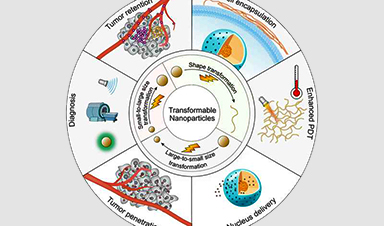For more than three decades, biomedical nanomaterials have been successfully developed for the benefit of theranostics—a compound term referring to the diagnoses and treatment of tumors. The nanoparticles must reach the tumor site and its distinct microenvironment to target the treatment for the tumor.
In Applied Physics Reviews, researchers from China and the United States examine how biology triggers morphological changes in certain types of nanoparticles. These types of particles are called smart transformable nanoparticles, because they can alter their size and shape upon stimulation from their surrounding environment.
These smart transformable nanoparticles are particularly promising for tumor theranostics because their physical properties will adapt to the physiology. These adaptations improve particle circulation, biodistribution, tumor penetration, tumor retention, and subcellular distribution for targeted therapy.
“Smart transformable nanoparticles can alter their morphologies under different physiological conditions as the therapeutic demands,” said co-author Jianxun Ding. “In our study, we reveal the structural designs for these smart systems as well as the in-depth mechanisms of the transformations.”
The researchers present the designs of transformable nanoparticles as a guideline for their construction and discuss the biomedical applications in the realm of theranostics. Ding and his colleagues showcase their insight through novel classifications for nanoparticle transformation design and the mechanisms contributing to the change.
For instance, the researchers divide the design transformation into two broad categories: size and shape. For size-transformable nanoparticles, the alterations are further divided into small-to-large and large-to-small transformations. The study discloses detailed and rational designs of transformable nanoparticles based on their structures.
As for the mechanisms contributing to nanoparticle transformation, “we believed the structure and stimuli both made a great contribution,” said Ding. “For example, different pH values decided the accurate site for the transformation, which correlate to varying physiological, extracellular, and endo/lysosomal conditions.”
Nanoparticles with constant physical morphologies have been widely investigated and applied in tumor theranostics in the past, while more recent studies of nanoparticle transformation phenomena have focused primarily on the response to stimuli. Until now, however, there has not been an in-depth discussion on the designs and applications of morphology-transformable nanoparticles.
“Our review covers the structure design, mechanism for transformation, and biomedical application of smart transformable nanoparticles, and includes perspectives on their limitations as well,” said Ding. “We believe this review will shed light on this important field.”
News
Scientists discover cancer-fighting bacteria that ‘soak up’ forever chemicals in the body
A family of healthy bacteria may help 'soak up' toxic forever chemicals in the body, warding off their cancerous effects. Forever chemicals, also known as PFAS (per- and polyfluoroalkyl substances), are toxic chemicals that [...]
Johns Hopkins Researchers Uncover a New Way To Kill Cancer Cells
A new study reveals that blocking ribosomal RNA production rewires cancer cell behavior and could help treat genetically unstable tumors. Researchers at the Johns Hopkins Kimmel Cancer Center and the Department of Radiation Oncology and Molecular [...]
AI matches doctors in mapping lung tumors for radiation therapy
In radiation therapy, precision can save lives. Oncologists must carefully map the size and location of a tumor before delivering high-dose radiation to destroy cancer cells while sparing healthy tissue. But this process, called [...]
Scientists Finally “See” Key Protein That Controls Inflammation
Researchers used advanced microscopy to uncover important protein structures. For the first time, two important protein structures in the human body are being visualized, thanks in part to cutting-edge technology at the University of [...]
AI tool detects 9 types of dementia from a single brain scan
Mayo Clinic researchers have developed a new artificial intelligence (AI) tool that helps clinicians identify brain activity patterns linked to nine types of dementia, including Alzheimer's disease, using a single, widely available scan—a transformative [...]
Is plastic packaging putting more than just food on your plate?
New research reveals that common food packaging and utensils can shed microscopic plastics into our food, prompting urgent calls for stricter testing and updated regulations to protect public health. Beyond microplastics: The analysis intentionally [...]
Aging Spreads Through the Bloodstream
Summary: New research reveals that aging isn’t just a local cellular process—it can spread throughout the body via the bloodstream. A redox-sensitive protein called ReHMGB1, secreted by senescent cells, was found to trigger aging features [...]
AI and nanomedicine find rare biomarkers for prostrate cancer and atherosclerosis
Imagine a stadium packed with 75,000 fans, all wearing green and white jerseys—except one person in a solid green shirt. Finding that person would be tough. That's how hard it is for scientists to [...]
Are Pesticides Breeding the Next Pandemic? Experts Warn of Fungal Superbugs
Fungicides used in agriculture have been linked to an increase in resistance to antifungal drugs in both humans and animals. Fungal infections are on the rise, and two UC Davis infectious disease experts, Dr. George Thompson [...]
Scientists Crack the 500-Million-Year-Old Code That Controls Your Immune System
A collaborative team from Penn Medicine and Penn Engineering has uncovered the mathematical principles behind a 500-million-year-old protein network that determines whether foreign materials are recognized as friend or foe. How does your body [...]
Team discovers how tiny parts of cells stay organized, new insights for blocking cancer growth
A team of international researchers led by scientists at City of Hope provides the most thorough account yet of an elusive target for cancer treatment. Published in Science Advances, the study suggests a complex signaling [...]
Nanomaterials in Ophthalmology: A Review
Eye diseases are becoming more common. In 2020, over 250 million people had mild vision problems, and 295 million experienced moderate to severe ocular conditions. In response, researchers are turning to nanotechnology and nanomaterials—tools that are transforming [...]
Natural Plant Extract Removes up to 90% of Microplastics From Water
Researchers found that natural polymers derived from okra and fenugreek are highly effective at removing microplastics from water. The same sticky substances that make okra slimy and give fenugreek its gel-like texture could help [...]
Instant coffee may damage your eyes, genetic study finds
A new genetic study shows that just one extra cup of instant coffee a day could significantly increase your risk of developing dry AMD, shedding fresh light on how our daily beverage choices may [...]
Nanoneedle patch offers painless alternative to traditional cancer biopsies
A patch containing tens of millions of microscopic nanoneedles could soon replace traditional biopsies, scientists have found. The patch offers a painless and less invasive alternative for millions of patients worldwide who undergo biopsies [...]
Small antibodies provide broad protection against SARS coronaviruses
Scientists have discovered a unique class of small antibodies that are strongly protective against a wide range of SARS coronaviruses, including SARS-CoV-1 and numerous early and recent SARS-CoV-2 variants. The unique antibodies target an [...]





















